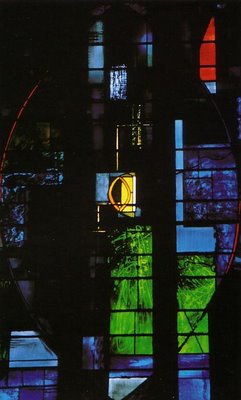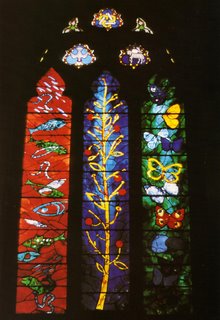John Piper and Stained Glass
OK, I've just lost everything that I have been posting for the past hour - extremely frustrating, especially as I may not remember my exact thoughts and feelings, but here goes...
John Piper started creating stained glass windows in the 1950s - he did not actually make the windows himself, but painted the 'cartoons' from which the stained glass maker worked.
The first one here is the West Window from St Paul's in Bledlow Ridge created in 1968, which is quite near to me so I must try to see it. In this " he has let his designs run right across the mullions from one light to another. It is a rhapsody in many shades of blue." [John Piper and Stained Glass, by June Osborne, 1997, Stroud: Sutton Publishers, 0-7509-1088-7]

This is the East Window of St Bartholomew's in Nettlebed, 1970.
Below are two examples of windows from Eton College Chapel: The Raising of Lazarus and the lower half of The Light under a Bushel.
 Although all the windows are exquisite I find that the top one - the West Window at St Paul's - is the most emotive. Even looking at the printed image I am enthralled by the "rhapsody of many shades of blue". Of course on the computer screen these images look even more stunning than in print, but still not approaching their beauty when light is streaming through.
Although all the windows are exquisite I find that the top one - the West Window at St Paul's - is the most emotive. Even looking at the printed image I am enthralled by the "rhapsody of many shades of blue". Of course on the computer screen these images look even more stunning than in print, but still not approaching their beauty when light is streaming through.
Light is a very powerful agent - the colours and images of stained glass windows were used to imbue churches with spiritual qualities. Today abstract images are often used in place of representational religious scenes, but personally I think the spiritual quality lies in the use of colour and light more than the imagery.
Piper uses much more blue in his work than other colours. I wonder, if red and orange were used almost exclusively, would the result be overpowering? In western culture at least, blue is viewed as a colour of calm, reflection, spirituality, whereas red and orange are very activating colours - more likely to be used when energy and activity is to be encouraged. I'd like to try using those colours and see what difference they make to mood.
Light is now used quite widely in the treatment of Seasonal Affective Disorder ( a form of depression attributed to the lack of light in winter, particularly in northern climates where the days are very short). I have long felt that light is very therapeutic and that coloured light can hugely affect mood and wellbeing. This is an area that I should like to look at in more depth, possibly by creating a space with variable light and colour...
Many fine artists have worked with stained glass - perhaps for the same reasons that I am drawn to it: the intense colours and feel of a piece when light is added, and the beauty of translucent materials. Henri Matisse, Fernand Leger, Georges Rouault, Georges Braque, and Marc Chagall were all attracted to stained glass, and probably many more that I haven't found yet.
I also see a parallel with stage lighting. The way that light can be mixed on stage to create any mood required for the production is fantastic and may point the way for me with my 'mood room'. Hockney, for one, is a fine artist who designed stage sets - one I can remember bathes the stage in blue - the Mikado maybe? I must look into that for next time...


7 Comments:
Guadi also brought stainglass into contemporary use via Sigada Famila (I saw first hand last December). It seems to me direct sunlight is far more stimulating than reflected light!
Sunil
Is that Francesco Guardi?
Where did you see them?
Yes I agree that direct sunlight is much more stimulating, but I do like the interplay between matt and glossy surfaces - especially the black glass pieces by Albers. I think that is more applicable to my SIP project though.
MA Drawing as Process
Dear All
Hope CCOD is going well, some interesting developments with your blogs.
I have your mentors set up, so I thought we could meet in the MA DAP studio on Wednesday 29th March, 10.30am to instigate this.
We will probably only need 30mins.
See you then
Amanda
I was just reading back through your blog and wondered if you had considered looking at the use of light in painting? Not literal light but how the suggestion of light has been recreated through media and used as symbolism and for creating mood and expression in painting. For example the creation of the illusion of light in the work of the 'great masters'. Have you seen The Vanities of Human Life (1645) by Harmen Steenwyck. This would sit nicely within the historical context of light in art. Also (but probably not very useful?) lighted candles have been used as symbolism in art representing fertility, the inevitability of death and the transience of life! Mx
Group 5 – Mentor
Dale Cochrane
daleco@gmail.com
My degree is in Graphic Media Communication, my specialism is illustration. Myself and a group of others set up a creative design business called chemistry is cooking.. i now work with one of the former members of this group - our work can be seen on www.dogsalad.com. i am located in Bradford where i teach on a part time basis(25 hrs!) at Bradford College on ND Multimedia. i am also course leader on a schools program, Fashion and Interactive Use of Media. I am currently studying on PCET HE - teacher training on a part time basis.
Lynda Cornwell - http://visual-language.blogspot.com/
Maria Edney – http://mariaedney.blogspot.com/
Introducing yourself to your mentor:
Can you each individually contact your mentor and introduce yourselves with a short paragraph.
Enclose you weblog address and email address.
Mentors have agreed to feedback to you weekly, offering support, entering into discussion and putting forward references etc…..
Project feedback from Mentors and students can be placed on the project blog.
Mentoring will run until the last week of May 2006, so for the next 8 weeks.
I hope you find it a useful support and will feed directly into your project.
Olafur Eliasson's work 'the weather project' might be relevant.
..and the effect that the artificial sun light had on people in tate's turbine hall. we all felt like laying down dozing, as if the turbine hall was a park
Re: Harmen Steenwyck - I have tracked down an image of The Vanities of Human Life - I'll post one shortly - and it really epitomises light in painting - thanks Maria.
Re: Olafur Eliasson's weather project - yes I lay on the ground beneath it too - I found it a rather unreal experience, a strange glow, rather discomforting actually with none of the benefits of the real thing, but strangely energy-sapping! - thanks Agot.
Post a Comment
<< Home